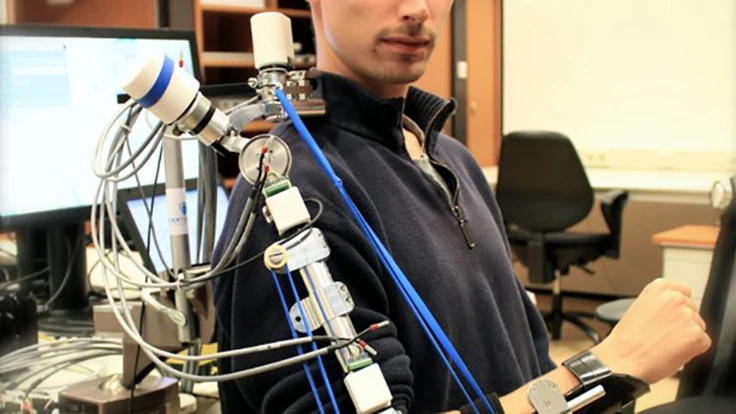
Netherlands – Researchers from the MIRA research center, together with the VUmc, TU Delft, and the Radboud umc, have developed the A-Gear: a robotic arm that can support the daily activities of people suffering the muscular disease Duchenne Muscular Dystrophy. They recently put the final touches to the first prototype for a discreet, body-connected support aid that can be worn under the clothing and that can support independent operation of the arm during important daily activities.
Duchenne Muscular Dystrophy
Duchenne Muscular Dystrophy occurs in approximately 1 in 5000 live born boys. The muscles of Duchenne Muscular Dystrophy patients become weaker during their life. As a result, boys with Duchenne lose the ability to use their arms until, eventually, they are unable to use them at all. Medicines can slow the progress of the disease and increase the life expectancy of boys with Duchenne, which means preserving the functionality of their arms becomes even more important. There are a few support aids that can recapture the loss of muscle function in the arms, but these support aids do not compensate for the entire loss of function and can result in stigmatization.
Active and passive support
During the past four years, the researchers have been working on two arm supports: a passive arm support – controlled by the user, without motors – and an active arm support – powered by motors that are controlled by the user. The active arm support is controlled by electrical (EMG) muscle signals or minimum muscle strength from the arm, which makes movement as intuitive and natural as possible.
In order to assess their design, the researchers compared the arm functionality of boys with Duchenne with and without A-Gear arm support.
"During the research, there were a number of participants who had been unable to independently move their arms for between three and five years and they were able to complete the tests set out in the tasks. The freedom of movement and the functionality of the arm increased when the subjects used the prototype. In addition, the movements required less energy," adds Joan Lobo-Prat, researcher at the MIRA research center for Biomedical Technology and Technical Medicine.
Development of the disease
The researchers not only looked into a technical solution, they also obtained more insight into the development of arm function in boys and men with Duchenne Muscular Dystrophy through the Duchenne Dynamic Arm Study (DDAS). By measuring the arm function of patients of different ages, they were able to obtain an impression of how the arm function changes over the course of the illness and accordingly, how to adjust the arm support over time.
Continuation
Although the results of the A-Gear project have provided new insights into the appearance of support aids such as these, much work is yet to be done in various areas. At the moment, a review is being carried out to work out what the next steps should be to convert the prototype into a product that can be used effectively.
Organization
The A-Gear project is an initiative of the Stichting Flextension (Flextension Foundation), which was initiated by the Duchenne Parent Project. Flextension started in 2007 as a result of questions from the Duchenne community about what engineering and technology could do to improve the quality of life for boys with Duchenne. The objective of Flextension is the development of new support aids that improve the quality of life for people with Duchenne.
The project is made possible by STW, UPPMD, Prinses Beatrix Spierfonds, Spieren voor spieren, Johanna Kinderfonds, Kinderrevalidatiefonds Adriaanstichting, Focal Meditech, Intespring, OIM Orthopedie, and Ambroise.
Source: University of Twente
Latest from Today's Medical Developments
- IMTS 2026 runs Sept. 14-19 at McCormick Place in Chicago, Illinois
- Master Bond’s MasterSil 800Med
- ZEISS celebrates 100 years of advancing innovation in the US
- Teleflex sells acute care and urology businesses for $2.03 billion
- HANNOVER MESSE: Where research and manufacturing meet
- What’s next for the design and manufacturing industry in 2026?
- Arcline to sell Medical Manufacturing Technologies to Perimeter Solutions
- Decline in German machine tool orders bottoming out





